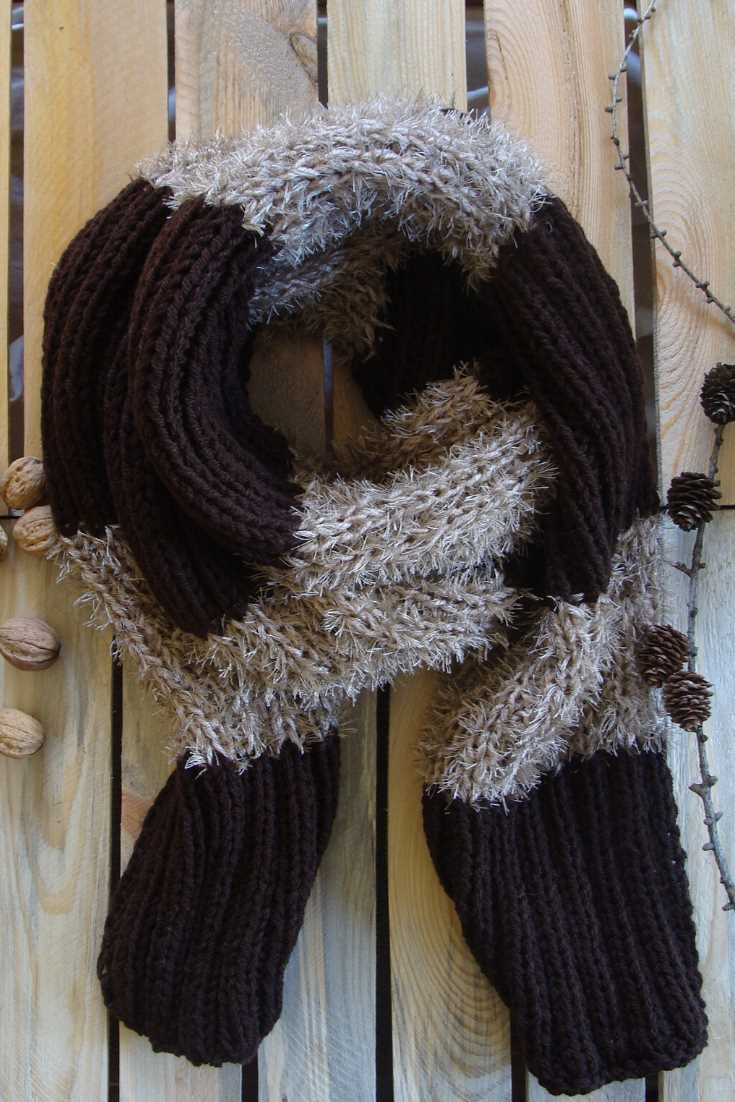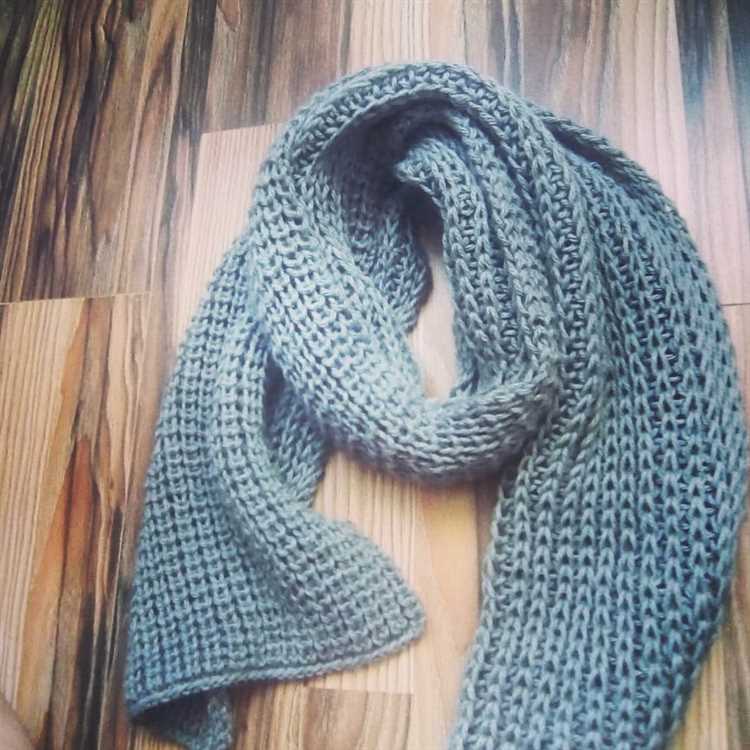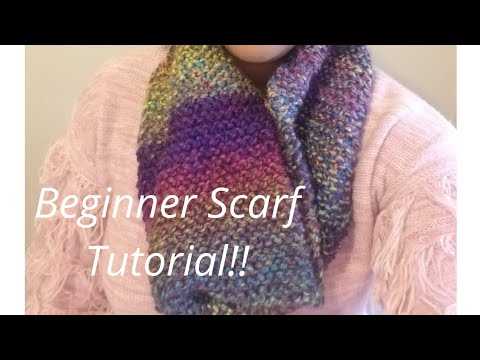Knitting a scarf can be a rewarding and therapeutic pastime, but reaching the end of your project can sometimes be a bit daunting. However, with a few simple steps, you can confidently finish off your knitted masterpiece and have a beautiful scarf to show off or give as a gift.
Step 1: Bind off
The first step to ending your knitted scarf is to bind off. This is the process of creating a secure edge that will prevent your stitches from unraveling. To bind off, simply knit the first two stitches in the usual way, and then pass the first stitch over the second stitch and off the needle. Continue this process until you have one stitch remaining, and then cut the yarn, leaving a long tail.
Step 2: Weave in the ends
With the remaining yarn tail, thread it onto a yarn needle and weave it through the stitches on the bound off edge. This will secure the end of the scarf and prevent any unraveling. Take care to weave the tail in a zigzag pattern, going up and down through the stitches, until you reach the end of the scarf. Once you’ve reached the end, trim any excess yarn.
Step 3: Block the scarf
Blocking is an important step in finishing a knitted scarf, as it helps to even out the stitches, give the scarf a polished look, and enhance its drape. To block your scarf, fill a sink or basin with lukewarm water and add a small amount of wool wash or mild detergent. Gently submerge the scarf in the water, making sure it is fully saturated, and let it soak for about 10 minutes. Then, remove the scarf from the water and gently squeeze out the excess moisture. Lay the scarf flat on a clean towel, shape it to your desired dimensions, and let it dry.
Remember, the key to successfully ending a knitted scarf is to bind off securely, weave in the ends, and block the finished piece. With these simple steps, you’ll have a professional-looking scarf that you can wear or gift with pride.
Choosing the perfect finishing technique
When it comes to finishing your knitted scarf, there are several techniques that you can choose from. The finishing technique you choose will depend on the desired look and feel of your scarf. Here are some popular options:
- Bind-off: This is the most common finishing technique for scarves. It involves knitting or purling the stitches together and then pulling the yarn through the remaining loop. This creates a neat and secure edge.
- Garter stitch border: Adding a garter stitch border to your scarf can provide a nice finished look. To create a garter stitch border, simply knit every row for a certain number of stitches at the beginning and end of each row.
- Ribbing: Ribbing can add a stretchy and textured finish to your scarf. This technique involves alternating knit and purl stitches in a specific pattern, such as k1, p1 or k2, p2.
- I-cord: If you’re looking to add a decorative element to your scarf, an I-cord edge can be a great choice. An I-cord is created by knitting a small tube of stitches using double-pointed needles.
Ultimately, the finishing technique you choose will depend on your personal preference and the overall style of your knitted scarf. Take the time to experiment with different techniques to find the one that suits your project best. Whether you opt for a simple bind-off or a more intricate border, the finishing technique can greatly enhance the overall look of your knitted scarf.
Preparing the needle and yarn
Before you can end your knitted scarf, you’ll need to gather the necessary supplies: a sewing needle and a length of yarn that matches or complements the color of your scarf.
1. Sewing Needle: Choose a sewing needle with a large eye, as you’ll need to thread the yarn through it. A tapestry needle or a large-eyed darning needle would work well.
2. Yarn: Select a length of yarn that is long enough to comfortably work with. This will depend on the width of your scarf and the desired length of the end you want to create. Cut the yarn to the desired length, leaving some extra for weaving in the end.
If you prefer a neater look, you can also use a separate length of yarn for the end instead of cutting it from the main ball.
3. Secure the stitches: To prevent your scarf from unraveling, make sure all your stitches are secure. If you have any loose stitches, use a crochet hook or a smaller knitting needle to tidy them up.
4. Thread the needle: Thread one end of the yarn through the eye of your sewing needle, leaving a small tail. This will be used to secure the end of the yarn and prevent it from slipping out.
5. Lay out your scarf: Lay your scarf flat on a table or a clean surface. Smooth it out to make it easier to work with and ensure that all stitches are visible.
Now that you have your needle and yarn ready, you can proceed to the next steps of ending your knitted scarf.
Casting off your stitches
Once you have finished knitting your scarf, it is important to properly cast off your stitches to secure the edges and prevent them from unraveling.
To cast off your stitches, follow these steps:
- Knit the first two stitches as usual.
- Using the left-hand needle, lift the first stitch over the second stitch and let it drop off the right-hand needle. You will now have one stitch remaining on the right-hand needle.
- Knit the next stitch.
- Again, lift the first stitch over the second stitch and let it drop off the right-hand needle. You should now have one stitch remaining on the right-hand needle.
- Continue this process of knitting one stitch and lifting the previous stitch over it until you have only one stitch left.
- Cut the yarn, leaving a tail that is long enough to weave in later.
Once you have cast off all the stitches, gently pull the yarn through the last stitch to secure it. This will prevent the scarf from unraveling.
Finally, weave in any remaining ends by threading them onto a tapestry needle and stitching them into the scarf. This will ensure that your scarf has a neat and finished appearance.
Securing the loose ends
After finishing the last row of your knitted scarf, you will have two loose ends of yarn that need to be secured.
1. Thread the loose ends onto a yarn needle. Start by threading one loose end onto a yarn needle. Make sure to leave a long enough tail so that you can weave it into the scarf without it coming undone.
2. Weave in the loose ends. Insert the yarn needle under the stitches on the wrong side of the scarf, and weave the needle in and out of the stitches. Make sure to pull the yarn gently to prevent any gaps or puckering. Continue weaving the yarn until you feel that it is secure, typically for about 2-3 inches.
3. Trim off the excess yarn. Once you are satisfied with how securely the loose end is woven into the scarf, carefully trim off any excess yarn using sharp scissors. Be careful not to cut any of the knitted stitches.
4. Repeat for the other loose end. Repeat steps 1-3 for the other loose end of yarn, making sure to leave a long enough tail for weaving and trim off any excess yarn once it is secure.
5. Block the scarf (optional). If you want your scarf to have a more polished and finished look, you can block it. Blocking involves soaking the scarf in water, shaping it to the desired dimensions, and allowing it to dry. This step helps to even out any irregularities in the stitches and gives the scarf a more professional appearance.
Congratulations! You have successfully secured the loose ends of your knitted scarf. Now you can enjoy wearing or gifting your beautiful creation!
Blocking the scarf for a polished look
Blocking is an important step in finishing your knitted scarf to give it a polished and professional look. It helps to even out the stitches and shape the scarf to its intended dimensions. Here’s a step-by-step guide on how to block your knitted scarf:
- Prepare your blocking materials: You will need blocking mats or a clean towel, rust-proof pins, and a spray bottle filled with lukewarm water.
- Pin the scarf to the blocking mats: Lay out the scarf on the blocking mats or towel, making sure it is flat and not stretched. Use rust-proof pins to secure the edges and corners of the scarf, keeping it in the desired shape and dimensions.
- Mist the scarf with water: Lightly mist the scarf with the spray bottle filled with lukewarm water. Make sure to dampen the entire scarf, but avoid soaking it.
- Leave the scarf to dry: Allow the scarf to dry completely before removing the pins. This may take several hours to a day depending on the thickness of the yarn and the humidity in the air.
- Finishing touches: Once the scarf is dry, gently remove the pins and admire your blocked scarf. It should now have a polished and even appearance, ready to be worn or gifted.
Blocking is an optional step, but it can greatly enhance the final look and feel of your knitted scarf. It is particularly beneficial for lace or intricate stitch patterns, as it opens up the design and showcases the details. Remember, the key to successful blocking is to be gentle and patient, allowing the scarf to dry completely before handling.
Creating decorative borders
Adding a decorative border to your knitted scarf can be a great way to personalize it and give it a unique touch. There are several different techniques you can use to create decorative borders, depending on the look you want to achieve.
- Lace border: Knitting a lace border can add a delicate and feminine touch to your scarf. Choose a lace pattern that complements the rest of your scarf and follow the instructions to knit the border.
- Cable border: Cables are a popular choice for creating decorative borders. You can knit a simple cable border or experiment with more complex cable patterns. The texture created by the cables will add visual interest to your scarf.
- Ribbed border: Ribbing is a classic choice for a border. The elasticity of the ribbing will help keep the edges of your scarf from curling and can give it a finished look.
- Colorful trim: Adding a contrasting color to the edges of your scarf can be a fun way to create a decorative border. You can knit the border using a different colored yarn or use duplicate stitch or embroidery to add color after the scarf is finished.
If you want to create a more structured and defined border, you can also consider adding a crochet edging. Crochet edgings can be worked directly onto the live stitches of your scarf and can create a variety of different effects.
Before adding a decorative border to your scarf, it’s a good idea to practice the technique on a swatch or small sample piece to make sure you’re happy with the result. Once you’re confident in your skills, you can start adding the border to your scarf, following the pattern instructions or your own design.
Adding fringe or tassels
To add a decorative fringe or tassels to your knitted scarf, follow these steps:
-
Determine the length of the fringe or tassels: Decide how long you want your fringe or tassels to be. Measure a representative sample and multiply it by the desired length to determine the total length of yarn needed.
-
Cut the yarn: Cut lengths of yarn equal to twice the desired length of the fringe or tassels.
-
Prepare the fringe or tassels: Take one piece of cut yarn and fold it in half. Insert the folded end through the edge of the scarf, creating a small loop. Pull the loose ends of the yarn through this loop and tighten to secure the fringe or tassel. Repeat this step along the entire edge of the scarf, spacing the fringes or tassels evenly.
-
Trim the fringe or tassels: Once all the fringes or tassels are in place, trim them to the desired length, if necessary.
-
Finish the ends: To prevent unravelling, tie a knot at the end of each fringe or tassel, or use a small amount of fabric glue or clear nail polish to secure the yarn ends.
Adding fringe or tassels is a great way to personalize your knitted scarf and add a stylish finishing touch. Experiment with different yarn colors and textures to create a unique look!
Voila! Your knitted scarf is complete!
Congratulations! You’ve finished knitting your scarf. It’s time to admire your work and show it off to the world. Whether you’re a beginner knitter or an experienced one, completing a project like this is always satisfying.
Here are some final steps you can take to ensure your scarf looks its best:
- Weave in loose ends: Take a yarn needle and carefully weave in any loose ends on your scarf. This will give it a polished look and prevent any unraveling.
- Block your scarf: Blocking is a process that helps shape and even out your knitting. Wet your scarf with cold water, gently squeeze out excess water, and then lay it flat on a clean towel. Use pins to shape it to the desired dimensions and let it dry completely.
- Add fringe or other embellishments: If you want to personalize your scarf even further, you can add fringe, tassels, or other decorative elements. Be creative and have fun!
- Show off your creation: Finally, wear your scarf proudly! It’s the perfect accessory to keep you warm and stylish during the colder months. Consider taking pictures of your finished scarf and sharing them on social media or with friends and family.
Remember, knitting is a skill that takes time and practice to master. Enjoy the process and be proud of your accomplishments. Your knitted scarf is a testament to your creativity and perseverance. Now, go out and enjoy the warmth and coziness of your handmade scarf!
FAQ:
What is the best way to end a knitted scarf?
The best way to end a knitted scarf is to bind off your stitches. This creates a neat edge and prevents the stitches from unraveling. You can use a basic bind off or a decorative bind off, depending on the look you want for your scarf.
Can I simply cut the yarn when I’m done knitting the scarf?
No, it is not recommended to simply cut the yarn when you’re done knitting the scarf. This can cause the stitches to unravel and your scarf to come apart. It is always best to properly bind off your stitches to create a secure and finished edge.
Do I need any special tools to end a knitted scarf?
No, you don’t need any special tools to end a knitted scarf. All you need is a pair of knitting needles and a yarn needle. The knitting needles will help you bind off the stitches, and the yarn needle will allow you to weave in the loose ends.
What should I do with the loose ends of yarn when ending a knitted scarf?
When ending a knitted scarf, you should use a yarn needle to weave in the loose ends. This means threading the yarn through the stitches of your scarf to secure the ends and prevent them from coming undone. Once you have woven in the ends, you can cut off any excess yarn.


